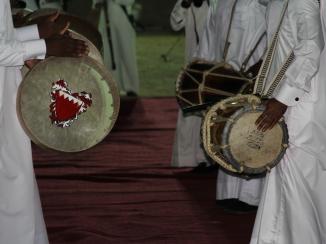Overview
For the British Library-Qatar Foundation Partnership, the author of this article digitised 62 shellac 78 rpm discs from recording sessions of the first congress of Arabic Music in Cairo in 1932. In one early CD edition, the liner notes mention (see Hassan and Cherif), for instance, that at that time the British label His Master’s Voice (HMV) released a total of 162 records. The most recorded artist was the well-known Iraqi Maqam singer, Muhammad Al-Qubanshi (1900/01-1989).
Shellac discs look like old vinyl LPs, but they are extremely fragile and only have a 3-minute playing time. They were produced from the 1920s to the 1960s, and therefore represent an important snapshot of early Arabic music recordings.
Invited by the Egyptian King Fu’ad I, hosted by the conservative Egyptian Academy of Oriental Music, and organised by a small group of European and Egyptian scholars, the Congress in Cairo took place from 14 March to 3 April 1932. Arabic and non-Arabic musicologists and musicians from northern Africa, the Levant A geographical area corresponding to the region around the eastern Mediterranean Sea. , Egypt, Turkey and Europe attended. The music of the Arabian Peninsula did not seem to be important. The exception was musicians from Iraq; the music being closely related to that of the Peninsula.
The Comparative Musicologists from Berlin and the ‘Orientalists’
The ethnomusicologist Ali Jihad Racy analysed the proceedings of this congress and he characterized it as “a significant landmark in world music history”. He broadly outlined the different positions as “a basic rift between Egyptians and Europeans, and to some extent among the Europeans or the Egyptians themselves.” Interestingly, the Egyptians especially followed the notion of the supremacy of western classical music over the developing ‘oriental’ or Arabic music. Racy related this to “Britain’s colonial domination of Egypt from 1882 to 1922”.
Museum directors and musicologists from the so-called Comparative Musicology group arrived from Berlin. There was Robert Lachman of the German National Library, Erich von Hornbostel, the director of the Phonogramm Archiv (sound archive) and Curt Sachs from the Musical Instrument Museum. During the congress, they were supported by Hungarian composer and music recordist Bela Bartok.
Generally, the Comparative Musicologists voiced the opinion that every music genre should be regarded within its own music system. Next to Arabic art music, they highlighted the importance of folk music. With their views, they came very close to understanding the modern discipline of ‘ethnomusicology’.
A completely different opinion was voiced by the Egyptian experts from the Academy of Oriental Music and some of the philologists from France and England; for instance that of the well-known British historian Henry George Farmer.
These scholars intended to codify Arabic microtones on an equal-tempered-quartertone-scale. They generally regarded western classical music and its instruments as the highest development in music. As a result, they perceived Arabic music as developing.
In 1930s Egypt, the piano was regarded as the pinnacle of musical progress, and therefore the congress witnessed a lengthy debate on whether or not to use the piano. Today, it is hardly used in Arabic music, the reason being that the microtones of Arabic music cannot be represented by the 12 sounds of the western musical system. Fretless instruments, like the violin, can play microtones. Therefore, this instrument became part of Arabic music.
Despite the different opinions, the delegates of the Cairo Congress discussed these issues in a comradely atmosphere. One needs to consider that the congress took place just one year before the Nazis came to power in Germany, and seven years before the Second World War.
Above all, for the first time, Arabic and European music experts discussed the importance and perspective of ‘Arabic Music’.
Muhmmad Al-Qubanshi – The ‘Superstar’ from Iraq
The most recorded artist at this congress was the important pesta A short metred vocal piece sung after a long maqam performance. singer and Iraqi Maqam performer, Muhammad Al-Qubanshi. Al-Qubanshi modernised the performance by replacing and adding other instruments to the traditional Chalgi Baghdad A musical performance group and genre of Iraq. ensemble. Listeners commented on his faultless performances and on the composition of his new maqam and new lyrics. Through his recordings and innovative style, he had become the only superstar of the shellac times.
With him, for the first time in history, the genre Iraqi Maqam was recorded and published outside Iraq. Until today, Iraqi Maqam is regarded as the classical genre of Iraq. In 2003, UNESCO listed it as part of the intangible cultural heritage of humanity.
In his recordings, Al-Qubanshi is accompanied by a group of musicians from Baghdad. Yeheskel Kojaman lists them: Yehuda Shammash (goblet drum, table/darbuka), Abraham Shleh (daff, frame drum), Yusif Za‘rur (qanun, zither), Izra Haron (oud, lute), Saleh Shummail (joza, fiddle) and Yusif Patao (santour, dulcimer). Interestingly, the recordists took care to feature both the singer and the instrumentalists.

As one can see, those discussions that took place in Cairo are still important to us. Thanks to the congress facilitators and the British HMV label, one can still listen to the repertoire recorded in 1932 in Cairo.
Unfortunately, as Racy stated, “the direct impact of the comparative musicologists upon Egyptian thinkers seems to have been minimal” and “…the congress field recordings….appear to be of much greater interest to curious Western archivists and researchers than Arab theorists, let alone music students and professional musicians”. With these recordings now available online, this will hopefully change.
Listen to:
Playlist Iraq:





